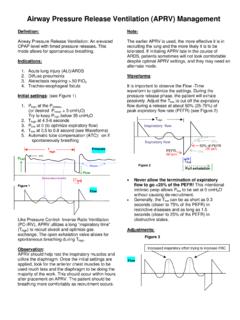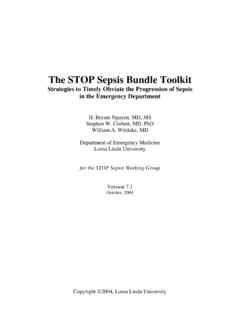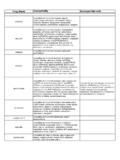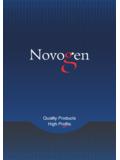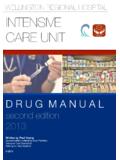Transcription of Vitamin C, Hydrocortisone and Thiamine For the …
1 1 | Page Vitamin C, Hydrocortisone and Thiamine For the treatment of Severe Sepsis and Septic Shock Vitamin C, Hydrocortisone and Thiamine dosing protocol Vitamin C: g IV q 6 hourly for 4 days or until discharge from the ICU. Hydrocortisone : 50mg IV push q 6 hourly for 6 days or until discharge from the ICU. Taper is not required. Thiamine : 200mg IV q 12 hourly for 4 days or until discharge from the ICU Vitamin C: Vitamin C is provided by the manufacturer as a 50 ml vial at a concentration of 500mg/ml. Three (3) ml of Vitamin C will be placed in a 100ml bag of either dextrose 5% in water (D5W) or normal saline and infused over 60 minutes. Hydrocortisone : Optional dosing strategy: Hydrocortisone 50 mg bolus, followed by a 24-hour continuous infusion of 200 mg for 4 days.
2 Thiamine : Intravenous Thiamine (200 mg) was placed in a piggyback in 50 ml of either D5W or normal saline and administered as a 15-minute infusion. 2 | Page Power Calculation: The published hospital mortality for patients with severe sepsis and septic shock in the USA approximates 40%. Based on our previous study and patient modeling we project that the combination of Hydrocortisone , Vitamin C and Thiamine could reduce the mortality to 15%. Assuming a type 1 error of 5% (alpha of ) and a power of 80% (the ability to detect a difference between two groups when a difference exists) would require a sample size of 100 patients. To account for dropouts and other exclusory factors we will therefore aim for a sample size of 140 patients. Data Collection: The following deidentified demographic and clinical data will be collected.
3 I. Age (18-90); patients over age 90 will be recorded as 90 years ii. Sex iii. Weight iv. Admitting diagnosis and site of infection v. Culture results vi. Co-morbidities, including diabetes, hypertension, cardiac failure, COPD, malignancy vii. Requirement for mechanical ventilation (Y/N). viii. Use of vasopressor agents (Y/N). The hourly dosage of vasopressors will be recorded as the norepinephrine equivalent dosage. [68,69] ix. Duration of vasopressor use x. Time to vasopressor independence form start of active drug/placebo xi. Daily urine output (for first 4 days) xii. Fluid balance after 24 and 72 hours xiii. Presence of acute kidney injury (AKI). Presence of AKI: Acute kidney injury (AKI) will be defined using the KDIGO criteria; namely, an increase of the s-creatinine > mg/dl or a level > times the baseline value.
4 [27] If the baseline s-creatinine is not known a value > mg/dl will be regarded as diagnostic of AKI. xiv. Length of ICU and hospital stay xv. ICU, hospital, 28-day and 60-day survival xvi. Routine laboratory data for 4 days including: a. serum creatinine b. white cell count (WBC) c. platelet count d. total bilirubin e. PaO2/FiO2 ratio f. Procalcitonin (PCT) g. lactate level xvii. The patients admission APACHE II and APACHE IV scores will be recorded. The APACHE IV score allows calculation of the predicted hospital mortality and predicted ICU length of stay (LOS). xviii. The daily SOFA (Sepsis-related Organ Failure Assessment) score will be recorded for the first 4 treatment days. 3 | Page The APAPCHE II score (incrementing score of 0-71) and APACHE IV score (incrementing score 0-286) are standardized measures of disease severity that are used to predict hospital mortality and ICU LOS.
5 [70,71] The SOFA score was designed to sequentially assess the severity of organ dysfunction in patients who are critically ill from sepsis (incrementing score 0-24). [72]. The SOFA scores is calculated 24 hours after admission to the ICU and daily thereafter. SOFA scores that increase by about 30 percent are associated with a mortality of at least 50 percent.[73] Data will be collected in the attached Excell spreadsheet (Appendix A Sepsis Data spreadsheet). No personal identifiers will be recorded on the spreadsheet. We will not be recording names, dates of birth, social security or EMR numbers or any other HPI data in the data collection spreadsheet. Each record will be assigned a unique study ID number (subject ID key). A separate password protected spreadsheet will have a list of subject ID number and the corresponding medical record numbers (Key data sheet).
6 This spreadsheet will only be accessible to the principle investor and sub-PI. The pharmacist will have a copy of the Key data sheet-Code with an additional field which will include the randomization code to active Vitamin protocol or placebo. Only the pharmacist will have access to the Key data sheet-Code until after the study is completed, when it will be made available to the principle investor and sub-PI. Data analysis: Summary statistics will be used to describe the clinical data and presented as mean SD, median with interquartile range (IQR) or percentages as appropriate. Chi squared analysis with Fisher s exact test (when appropriate) and Student s t test (Mann Whiney U test for non-normal distributions) were used to compare data between the active treatment group and the placebo group with statistical significance declared for probability values of or less.
7 4 | Page Data Safety & storage: The main risk to subjects is the accidental release of PHI. Careful record management methods will be in place to ensure this type of privacy breach does not occur. Subject ID Key: Each subject will be given a unique subject ID number. A subject ID key will be used to match the subjects Medical Record Number (MRN). The subject ID key, linking the subject ID numbers to the MRN will be kept in a password-protected file and stored separately from the data set in the locked office of the principal investigator and the pharmacist in charge of randomization. Only the research team (PI, sub PI and research pharmacist) will have access to this information, and they will not disclose this information to any other person or entity. The subject ID key will be destroyed as soon as possible after the data set has been completely abstracted and validated for accuracy and completeness.
8 Data set: Similarly, the data set will be kept in a password-protected file and stored separately from the subject ID key in the locked office of the principal investigator. Only the research team will have access to this information, and they will not disclose this information to any other person or entity. Three years after the completion of the study, all collected data will be destroyed by permanently deleting electronic copies. 5 | Page References 1. Adhikari NK, Fowler RA, Bhagwanjee S et al. Critical care and the global burden of critical illness in adults. Lancet 2010; 376:1339-46. 2. Kaukonen KM, Bailey M, Suzuki S et al. Mortality related to severe sepsis and septic shock among critically ill patients in Australia and New Zealand, 2000-2012. JAMA 2014; 311:1308-16.
9 3. Gaieski DF, Edwards JM, Kallan MJ et al. Benchmarking the incidence and mortality of severe sepsis in the United States. Crit Care Med 2013; 41:1167-74. 4. Silva E, de Almeida Pedro M, Beltrami Sogayar AC et al. Brazilian Sepsis Epidemiological Study (BASES study). Crit Care 2004; 8:R251-R260. 5. Sales JA, David CM, Hatum R et al. Sepse Brasil: Estudo Epidemiologico da Sepse em Unidades de Terapia Intensiva Brasileiras. An epidemiological study of sepsis in Intensive Care Units. Sepsis Brazil Study. Rev Bras Ter Int 2006; 18:9-17. 6. The10 leading causes of death by country income group 2012. WHO factsheets.. 2015. World Health Organization. 5-24-2016. 7. Wang HE, Szychowski JM, Griffin R et al. Long term mortality after sepsis. Chest 2013. 8. Artenstein AW, Higgins TL, Opal SM.
10 Sepsis and scientific revolutions. Crit Care Med 2013; 41:2770-2772. 9. Fisher BJ, Seropian IM, Masanori Y et al. Ascorbic acid attenuates lipopolysaccharide-induced acute lung injury. Crit Care Med 2011; 39:1454-60. 10. Fisher BJ, Kraskauskas D, Martin EJ et al. Attenuation of sepsis-induced organ injury in mice by Vitamin C. JPEN 2014; 38:825-39. 11. Han M, Pendem S, Teh SL et al. Ascorbate protects endothelial barrier function during septic insult: Role of protein phosphatase type 2A. Free Radic Biol Med 2010; 48:128. 12. Kim SR. Ascorbic acid reduces HMGB1 secretion in lipopolysaccharide-activated RAW cells and improves survival rate in septic mice by activation of Nrf2/HO-1 signals. Biochemical Pharmacology 2015; 95:279-89. 13. Bornstein SR, Yoshida-Hiroi M, Sotiriou S et al.
